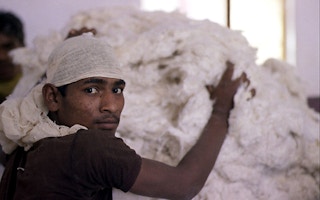In addition to the heavy losses incurred by excess rainfall during monsoon months, farmers in the Marathwada region of Maharashtra are now forced to sell cotton at low price, eventually pushing them towards debt.
Over 3.2 million hectares of agricultural land, as well as more than 4.8 million farmers, have been affected by excess rainfall between June and October last year, the peak monsoon months, according to data from the Aurangabad divisional commissionerate.
The production was affected by excess and erratic rainfall. In some areas, snails also caused damage to crops. There is no individual crop data to assess the damage to cotton.
Kishor Tawar, a farmer owning seven acres of land in Paithan taluka of Aurangabad district, told Down to Earth:
“Excess rainfall has caused a loss of about 50 per cent across the cotton belt region. I had grown cotton on four acres of irrigated land and managed to produce only 16 quintals against an expectation of 28 quintals.”
The losses are incredibly high and the selling prices have dropped recently, impacting even the recovery of production costs in some cases, Tawar said.
“
The cost of chemical fertilisers and pesticides increased this year and the changing weather demanded more pest control measures.
Parmeshwar Gholap, farmer, Pachegaon
“On an average a farmer has suffered a loss between two-five quintals per acre depending on land, soil and the amount of rainfall received,” he said.
Farmers will not be able to recover the production costs if the losses are high, he added.
The prices dropped from Rs 9,000 per quintal to Rs 6,000-Rs 6,500 per quintal this year, Tawar, who is also an activist with farmers’ body Shetkari Sanghatna.
“Earlier, the companies that procure cotton said the produce will elicit high demand and fetch good price, but the erratic weather has taken it all away,” he said.
Parmeshwar Gholap, a farmer with seven acres of land in Pachegaon of Beed district, said he produced 28 quintals of cotton, costing him Rs 1.30 lakh.
“The cost of chemical fertilisers and pesticides increased this year and the changing weather demanded more pest control measures,” he said.
Gholap said even if he fetches Rs 7,000 for a quintal, he will not even earn Rs 2 lakh. “I know the buyers will not buy at that price. How will I feed my family with Rs 40,000-50,000 for a year?” he asked.
The situation worsens every year. “Due to the same, farmers now think that the previous year was better than the current. The low price is demotivating the farmers,” Gholap said.
Rameshwar Gade, another farmer from the same village, said the central government’s interference is also to be blamed for the low cotton price.
The Securities and Exchange Board of India suspended cotton futures trading in the stock market in December. The suspension is for a year and it stopped potential investors from participating in cotton trading, which would have supported an increase in the production, he said.
The move would only benefit large textile companies, who can afford to buy cotton from farmers in bulk at a low cost, Gade said.
“Moreover, the cost of cotton per quintal ranges from Rs 9,000-Rs 12,000 in Maharashtra and neighbouring states like Telangana.
The rates are higher than international market by five per cent-10 per cent. In such a situation, the cotton export cost will have to be further reduced to encourage international buyers to procure from Indian farmers,” he added.
The overall situation is only worsening the state of cotton farmers, Gade said.
This story was originally published on Down to Earth.










